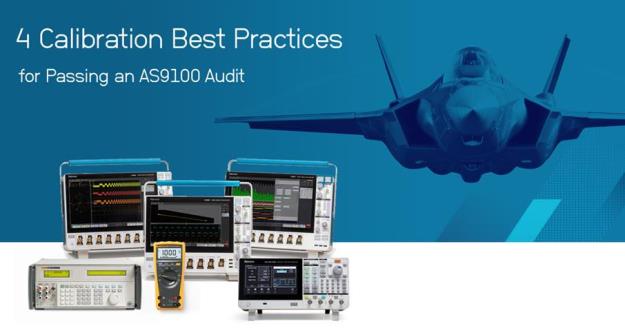For metrologists, test lab managers, and calibration coordinators in aerospace and defense manufacturing,
satisfying AS9100 calibration requirements can be an intense exercise requiring precise scheduling for whole labs of test and measurement equipment – all with the goal of keeping any downtime to a minimum.
Keeping and maintaining calibrations for AS9100 audits is essential but can be time consuming and produce significant paperwork. Perhaps not surprisingly, as reported by one aerospace auditing specialist, calibration is a leading source of non-conformance findings.
Our goal is to help you keep compliant. Here is a summary of the requirements plus four practical best practices you can use to satisfy AS9100 compliance and your labs up and running.
What is the AS9100 Spec for Calibrations?
An AS9100 audit requires the calibration of electronic test and measurement (T & M) equipment as stated in SAE’s AS9100 Standard, in the 7.1.5.2 Measurement Traceability clause:
When measurement traceability is a requirement, or is considered by the organization to be an essential part of providing confidence in the validity of measurement results, measuring equipment shall be:
a. Calibration or verified, or both, at specified intervals, or prior to use, against measurement standards traceable to international or national measurement standards; when no such standards exist, the basis used for calibration or verification shall be retained as documented information;
b. Identified in order to determine their status;
c. Safeguarded from adjustments, damage, or deterioration that would invalidate the calibration status and subsequent measurement results.
The organization shall establish, implement, and maintain a process for the recall of monitoring and measuring equipment requiring calibration or verification.
The organization shall maintain a register of the monitoring and measuring equipment. The register shall include the equipment type, unique identification, location, and the calibration or verification method, frequency, and acceptance criteria.
NOTE: Monitoring and measuring equipment can include, but are not limited to: test hardware, test software, automated test equipment (ATE), and plotters used to produce verification data. It also includes personally owned and customer supplied equipment used to provide evidence of product and service conformity.
Calibration or verification of monitoring and measuring equipment shall be carried out under suitable environmental conditions.
The organization shall determine if the validity of previous measurement results has been adversely affected when measuring equipment is found to be unfit for its intended purpose, and shall take appropriate action as necessary.

Best Practice Guidance for Calibration Compliance to AS9100
We suggest these four best practices to ensure success in satisfying the requirements:
1. Schedule. Create a calibration schedule, and make sure your equipment is all accounted for in the schedule. Be sure to include notifications and all documentation of calibration results and certificates. If you are managing your own calibration schedule for a lot of equipment, you may want to save time and hassle by asking an external calibration partner to create and implement the schedules for you. A calibration partner experienced in AS9100 compliance can offer you a proven system to ensure you keep compliant.
2. Software. Use a calibration software to help you manage the schedule. Perhaps you already have your own software, or a spreadsheet of some kind, to assist. Third parties can also help here, with software for calibration management such as
CalWeb, a cloud-based asset and calibration management solution that serves as an equipment register with the ability to provide immediate OOT notifications, assist in coordinating repair and calibration activities, and maintain documentation. Many of Tektronix’s aerospace and defense customers rely on CalWeb to manage their calibrations and preventative maintenance needs.
3. Checklist. Leverage an AS9100 checklist. Auditors love checklists, and so do we. We suggest you employ any number of AS9100 audit checklists available online, such as
this one (PDF) offered
by the AS9100 store, that specifies all the required steps in audit process.
4. Outsource. Consider a single-source calibration vendor, with a track record of success with aerospace and defense, both public and private organizations. The right calibration partner can deliver a host of benefits, including:
- Streamlined process. The calibration of all of your electronic test and measurement equipment with only one PO and partner to manage.
- Industry-proven expertise. A widely capable vendor will be able to deliver compliant and/or accredited calibrations, and a history of providing Z540 and ISO 17025 calibrations that pass AS9100 audits. Your vendor should also be able to perform onsite calibration services, take extra care if there’s a need to pick up/deliver/ship sensitive equipment, and understand that any firmware or software updates require your written permission.
- Be on schedule at all times. A trusted calibration vendor will maintain an accurate schedule, saving time and headaches, while keeping your overhead costs low.
- Considerate of the contract. Your calibration vendor should stick to contract deliverables and not perform services that are unnecessary and out-of-scope.
- Value-added relationship. Your calibration vendor should be able to provide expertise and advice, including suggestions for fine tuning your program for maximum efficiency. A dedicated team of service and support staff for your account should be a strong consideration.
- Zero downtime. Consider a vendor who can provide a loaner program to ensure zero downtime for critical equipment.
- OEM expertise. When selecting your vendor, consider a vendor that is also an OEM of T&M equipment to deliver equipment calibration expertise a level up from a third-party calibration house.
These best practices for passing AS9100 audits, and the benefits derived from outsourcing your calibration, are key steps toward the ultimate goals of reducing organizational risk, downtime, and cost.
As a leading calibration provider to military/aerospace organizations, Tektronix serves as the industry’s trusted partner for calibration services that pass AS9100 audits. With expert labs nationwide and onsite and offsite
calibration service options, Tektronix offers over 75 years of experience partnering with the world’s largest aerospace manufacturers including Raytheon, Boeing, NASA, the DoD, and others. Every day, Tektronix delivers certificated and accredited calibration services on over 140,000 different electronic test and measurement equipment models from more than 9,000 manufacturers.





